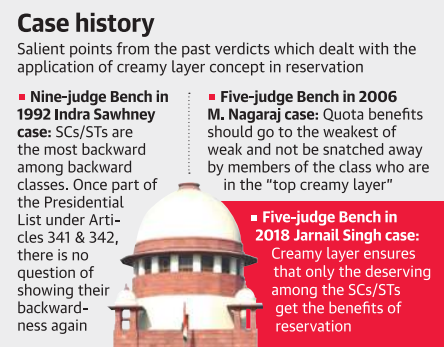Indian Polity
Sub Categorisation of Backward Classes
- 29 Aug 2020
- 8 min read
This editorial analysis is based on the article A Case For Equality which was published in The Indian Express on 29th of August 2020. It analyses the Supreme Court Judgement on sub categorisation of the SCs/STs and different dimensions related to it.
A five-judge Constitution Bench of the Supreme Court has recently ruled that states can sub-classify the list of Scheduled Castes (SCs), Scheduled Tribes (STs), and Socially and Educationally Backward Classes (SEBCs), to provide preferential treatment to the especially deprived among them “to achieve the real purpose of reservation”.
The Supreme Court of India has thus reopened the legal debate on sub-categorisation of Scheduled Castes and Scheduled Tribes for reservations, or what is commonly referred to as “quota within quota” for SCs and STs. However, the court has referred the issue to a larger Bench to decide.
What was the case?
- The present case before The Supreme Court of India was an appeal against the Punjab and Haryana High Court which had struck down a state law empowering the government to sub-classify SC/STs for grant of quotas.
- The High Court judgment had struck down a circular of the Punjab government, which provided that out of the seats reserved for SCs, 50 percent would be offered to Balmikis and Mazhabi Sikhs.
- The High Court in this judgement had relied on the Chinnaiah judgment for concluding so.
Meaning of Sub-Categorisation
- Scheduled Castes or Scheduled Tribes are made up of several castes which are not homogenous.
- It is argued that some of the castes among the category remain grossly under-represented despite reservation in comparison to other Scheduled Castes.
- This inequality within the Scheduled Castes is underlined in several reports, and special quotas have been framed to address it.
- The “creamy layer” concept puts an income ceiling on those eligible for reservation.
- While this concept applies to Other Backward Castes (OBCs), it was applied to promotions of Scheduled Castes for the first time in 2018.
- The central government has sought a review of the 2018 verdict and the case is currently pending.
Why was the issue referred to a larger bench?
- This was because in 2004 another five-judge Constitution Bench of the Supreme Court of India in EV Chinnaiah judgement had ruled that state governments had no power to create sub-categories of SCs for the purpose of reservation.
- Since a Bench of equal strength cannot overrule a previous decision, the court referred it to a larger Bench to settle the law.
- The larger Bench, whenever it is set up by the Chief Justice of India, will reconsider the two judgements.
Arguments For Sub-categorisation
- As India is a welfare state, its obligation is to undertake the emancipation of the deprived section of the community and eradicate inequalities.
- When the reservation creates inequalities within the reserved castes itself, it is required to be taken care of by the State making sub-classification and adopting a distributive justice method so that State resources do not concentrate in few hands and equal justice to all is provided.
- Justice involves redistribution and reallocation of resources and opportunities and equitable access to all public and social goods to fulfil the very purpose of the constitutional mandate of equal justice to all.
- Reservation was not contemplated for all the time by the framers of the Constitution.
- If sub-classification is denied, it would defeat the right to equality by treating unequal as equal.
- There are unequals within the list of Scheduled Castes, Scheduled Tribes, and socially and educationally backward classes.
- Various reports indicate that Scheduled Castes and Scheduled Tribes do not constitute a homogenous group.
- The Supreme Court has also stated that States can sub-classify SC and ST in the Central List to provide preferential treatment to the “weakest out of the weak”.
Arguments Against Sub-categorisation
- The argument is that the test or requirement of social and educational backwardness cannot be applied to Scheduled Castes and Scheduled Tribes.
- The special treatment is given to the SCs due to untouchability with which they suffer since ages.
- In the N M Thomas V/S State Of Kerala case in 1976, the Supreme Court itself has admitted that Scheduled Castes are not castes but they are a class and hence should be treated as a class.
- Sub categorisation will be used to appease one vote-bank or the other among the SC/ST and thus a cause of social justice would end being politicised.
Identification of SC/ST
- The Constitution, while providing for special treatment of SCs and STs to achieve equality, does not specify the castes and tribes that are to be called Scheduled Castes and Scheduled Tribes.
- This power is left to the central executive, The President, under Article 341.
- As per Article 341, those castes notified by the President are called SCs and STs.
- A caste notified as SC in one state may not be a SC in another state.
Conclusion
The Supreme Court of India in the landmark Mandal case had held that there was no constitutional bar on a state classifying SEBCs as backward and more backward. The constitutional goal of social transformation cannot be achieved without taking into account changing social realities.
|
Drishti Mains Question “Reservation in India is a system of affirmative action that provides representation for historically and currently disadvantaged groups in Indian society.” Discuss the statement in the light of the recent judgement of the Supreme Court on sub categorisation of SC and ST. |
This editorial is based on “Testing Times” which was published in The Indian Express on August 28th, 2020. Now watch this on our Youtube channel.







